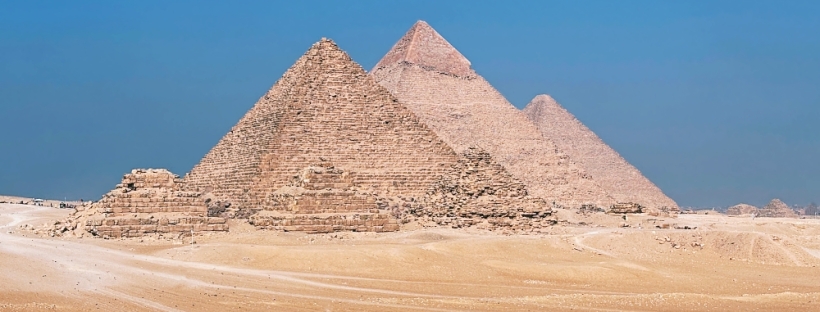I had dreamed of visiting Egypt since I was five years old, and finally fulfilled this childhood dream… but while the archeological sites themselves were as awe-inspiring as I’d always imagined, I frankly had a mostly frustrating and/or disappointing experience. Hindsight is 20/20, and this itinerary is what I wish I’d done in retrospect—I hope it will help anyone determined to see the stunning sites of Ancient Egypt without experiencing the same frustrations that I did.
I’d put my own two week itinerary together, and hired a driver and guide through a local travel agency for most of our trip. Do not attempt to navigate this country on your own, any Westerner willing to drive in Egyptian traffic has a death wish: I saw a grand total of two traffic lights, lane markings mean nothing, and the road is shared with tuk-tuks, camels, mules, and pedestrians in equal measure. However, I hesitate to recommend this option/the travel agency because our first guide was so terrible that we almost aborted our holiday after four days…! Our second guide in Upper Egypt was much better, even great, but I still did not enjoy this first experience of a guided holiday—I am an avid independent traveler, and even though I’d been the one to put the itinerary together, I didn’t feel like our days were filled. On most days, our sight-seeing was done by 2PM, yet I felt rushed at a lot of the sites and would’ve explored them far longer if I’d been on my own. So, if I were to do it over again, I would not book two full weeks, and I would only hire a driver to take us from place to place and wait while we visit them at our own pace.
The itinerary below covers everything we did in Cairo, Aswan and Luxor, but skips four days/two destinations we were disappointed in and wouldn’t recommend: The Mediterranean port city of Alexandria, and an uncomfortable and time-consuming excursion into the Western Desert. You could shave off two additional days by sticking to the tourist highlights and giving the day trip to the temples of Dendera and Abydos a miss, as well as taking the direct route from Aswan to Luxor, rather than the scenic detour that visits the temples of Kom Ombo, Edfu, and Esna on the way… these were however some of my personal favorites, and since you came all this way, I do recommend keeping them on the itinerary if you have the time to spare!
Day 1 · Arrival in Cairo
You need a visa to enter Egypt, which (for EU, US, and AU citizens) costs 25USD—you can either obtain it at the airport upon arrival, or save time and apply online before the trip, which is what we did. Wherever you’re coming from, the first day will more than likely be wasted getting here, as last entry to most of the sites is around 3 or 4PM, depending on the season. Rather than staying in Downtown Cairo, we opted for a hotel in Giza (an hour drive from CAI in normal traffic conditions), and I’d recommend one of the many hotels with view of the Giza plateau—there are options for every budget. These photos were taken from our hotel’s rooftop!

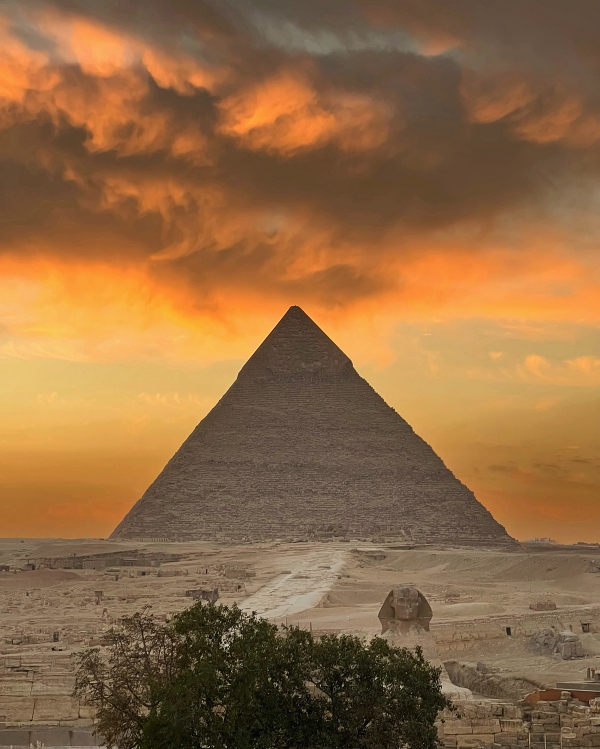
Once you’re settled, find an ATM and get some local currency—virtually all of the tourist sites are (exclusively) cashless now, but you will need Egyptian pounds (conversion rate as of March 2024: 100EGP = 3€ / 3.25USD) for baksheesh, tips, which are essential and expected standard practice, not optional. Also, stock up on bottled water—you do not want to drink tap water, that’s pretty much a guarantee for a gastrointestinal infection. It’s so common that people refer to it as the Pharaoh’s Curse, and the golden rule is: “Boil it, Cook it, Peel it, or Forget it”. Avoid salads, diluted juices and smoothies, and ask for your drinks without ice.
Day 2 · Saqqara, Dahshur, Memphis, and the Giza Plateau
Everyone knows the famous Giza Pyramids, but there are even older ones just a short drive from Cairo! Our day started at Saqqara, the necropolis of ancient Memphis, and Egypt’s largest archeological site. Its most recognizable feature is the Step Pyramid of Djoser, which inspired later pharaohs to build the pyramids, and is considered the oldest stone building complex in the world. The Pyramid of Unas was the first pyramid we went inside of, and we also visited several mastabas of nobles and generals, such as the tomb of Princess Idut. Our guided visit only lasted an hour, but I felt that you could easily spend half a day exploring the tombs—the Step Pyramid itself underwent a 14-year restoration, and the inside was recently opened to the public.

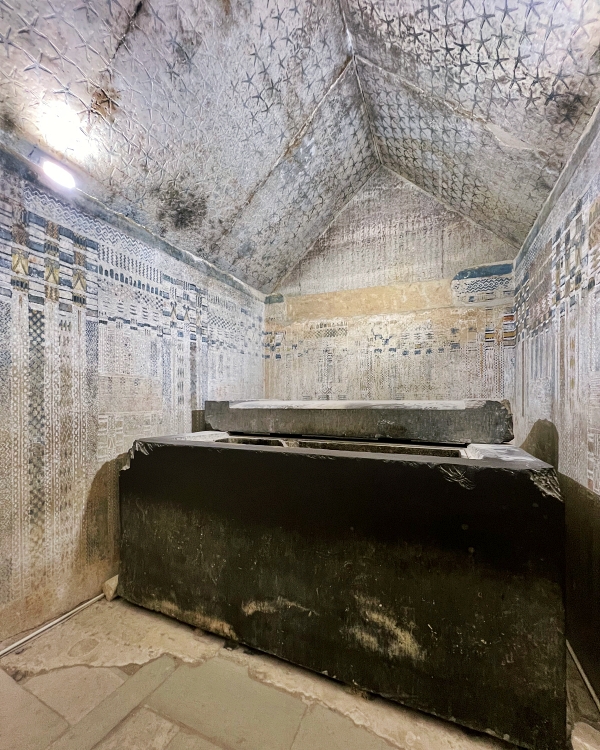
The next site was my highlight of the day: Dahshur, where the Ancient Egyptians perfected their pyramid-building skills. Although there were originally eleven pyramids here, only two remain intact: Egypt’s first true (and third-largest) pyramid, the Red Pyramid, which gets its name from the red limestone used in the construction, and an earlier version, the Bent Pyramid, the first attempt at building a smooth-sided one. It got its name because the angle of inclination was abruptly changed during construction in order to prevent the structure’s collapse, but it is also unique because the original limestone casing is largely intact. We spent an hour here, and climbing down the long, steep, tight passageways and breathing the stale, hot, and humid air felt like a real adventure (and a proper workout)—the Bent Pyramid in particular has only recently been reopened to tourists after 65 years, and there’s a bat colony living inside one of the upper chambers! I loved this experience, but consider skipping it if you suffer of (even mild) claustrophobia, asthma, or have problems with your knees or back—you will need to hunch over and squat, and the taller you are, the harder it will be. The Red Pyramid is easier, so I recommend starting with it; if it proves too challenging, skip going inside the Bent Pyramid.

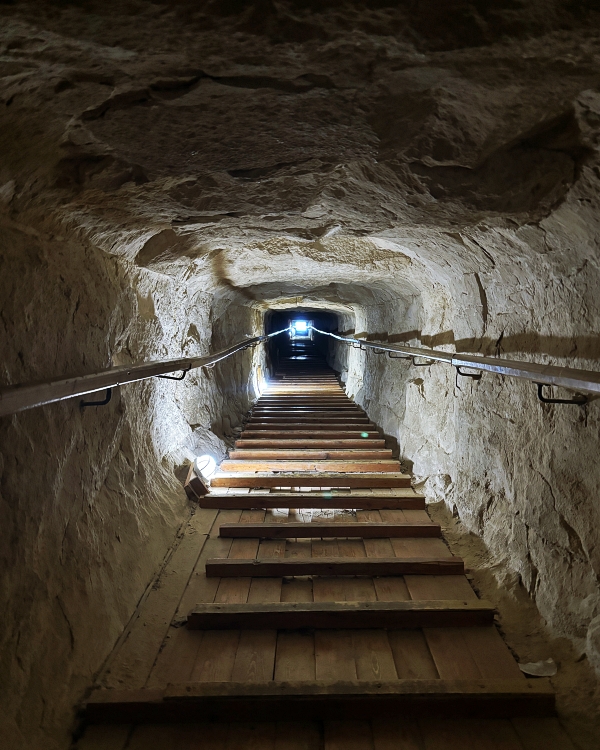
Next up was an open air museum in the town of Mit-Rahina, the only remaining evidence of Memphis, Ancient Egypt’s first capital city after the unification of Upper and Lower Egypt. Highlights include the colossal fallen limestone statue of Ramesses II and the alabaster sphinx, but it’s a quick visit, since most of what remains are just some foundations and stumps of pillars. Honestly, I don’t feel like we would’ve missed out on anything if we had skipped this stop, so if you’re short on time, this is something you can cut from the itinerary without regrets.
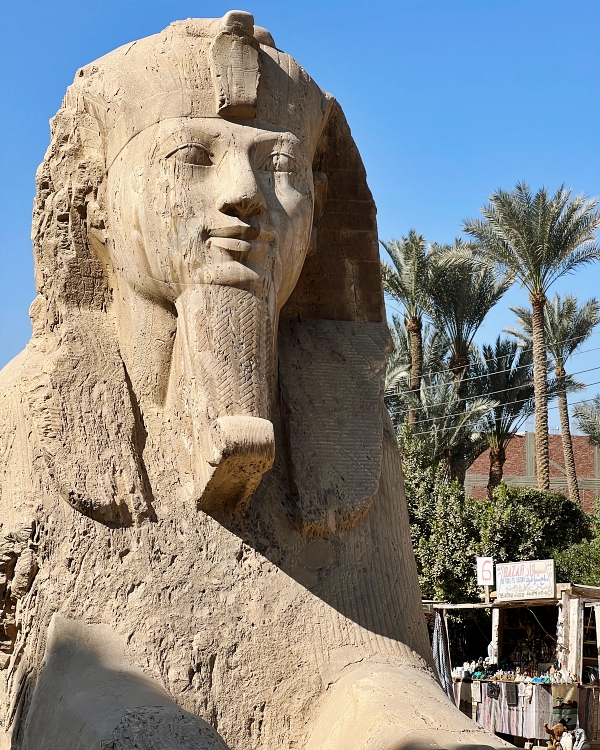

We ended the day at the Giza necropolis, the home of Egypt’s most emblematic monuments, built almost 5000 years ago. It includes the Great Pyramid (the oldest of the Seven Wonders of the Ancient World; also known as the Pyramid of Khufu or Cheops), the Pyramid of Khafre (my favorite because it retains some of its limestone casing at the top), the Pyramid of Menkaure, and the Great Sphinx (along with several smaller pyramids, temples, cemeteries, and the remains of a workers’ village). For an additional fee, you can go inside each of the three main pyramids (the fee for the Great Pyramid is considerably larger than for the other two)—we didn’t, and genuinely don’t feel like we missed out, but if you don’t mind the crowds and extra expense, it must surely be a thrill to stand inside the last remaining Wonder of the Ancient World.


Day 3 · Islamic Cairo & Egyptian Museum
Our day started in Islamic Cairo, the historic heart of the city, and a World Cultural Heritage Site. The first stop was the Citadel of Saladin, a medieval Islamic-era fortification which served as the seat of Egyptian government and its rulers’ residence for nearly 700 years. Today, it is a preserved historic site, including mosques and museums: The Mohammad Ali Mosque, also known as the Alabaster Mosque, modeled after the Blue Mosque in Istanbul, is situated at the citadel’s summit, making it the most visible mosque in all of Cairo. The view from the terrace surrounding it is stunning—on a clear day, you can see the Giza pyramids in the distance. We popped into the National Police Museum as well, but the English explanations were very badly translated… and uncomfortably nationalist. Next, we were taken to the Al-Azhar Mosque, the first mosque established in the city that eventually earned the nickname “City of a Thousand Minarets”: It blends several architectural styles as it was enlarged over a period of over a thousand years! Across the street from the mosque, you can get lost exploring the skinny lanes of the Khan el-Khalili bazar, located right next to al-Muizz Street, one of the city’s oldest. Our final stop of the day was the Egyptian Museum on Tahrir square in Downtown Cairo. It was incredible to see Tutankhamun’s treasures, but the building and presentation are quite dated, and a good chunk of its collection (such as most of the mummies) has been permanently moved to the National Museum of Egyptian Civilization, inaugurated in 2021, as well as to the not-yet-opened Grand Egyptian Museum in Giza. This evening, catch the sleeper train to Aswan.


Day 4 · Aswan
The sleeper train is the most cost- and time-effective way of traveling the almost 900km to Aswan, Egypt’s southernmost city—and it was surprisingly comfortable, with dinner and breakfast included in the ticket price. Still, after a twelve hour overnight journey, you’ll probably want to take it easy, and Aswan, with its tranquil Nile valley scenery, is the perfect place to slow down the pace after chaotic Cairo. Our first stop was the island-based Philae Temple complex, dedicated to Isis; you get some of the best views from the motor boat that will take you to Agilkia island (a ten minute ride each way, the fare is not included in the admission fee), and you can pay a little extra to climb one of the pylons for a wonderful panoramic view of the temple complex and Nile river. Philae spent most of the 20th century submerged in the Nile after the British prioritized modernization over preservation and built the Aswan Low Dam in 1902; it is one of many ancient monuments in Nubia that was eventually dismantled and moved to a nearby island on higher ground, block by block. The project was the greatest archaeological rescue operation of all time, and led to the creation of the modern system of UNESCO World Heritage Sites! Aswan was the source of Ancient Egypt’s finest granite, and our next stop was the Unfinished Obelisk: At 42 meters and almost 1200 tons, it would have been the world’s largest obelisk and the single heaviest piece of stone ever fashioned…. but it cracked during extraction, and was abandoned in the quarry. After the overnight train, we were tired, and A. was sick, so we skipped a visit to the Nubian Museum as well as the climb to Qubbet el-Hawa, a necropolis for nobles and priests, and called it a day. I would have loved to stay at the historic Old Cataract Hotel, where Agatha Christie wrote and set parts of Death on the Nile and Churchill used to vacation… alas, it was out of our budget. We decided against staying in Aswan proper altogether, and booked a hotel in the Nubian village of Gharb Suhayl—it’s on the Western Bank and a bumpy car ride to get here (or take a boat), but I loved all the colorful mud-brick buildings.
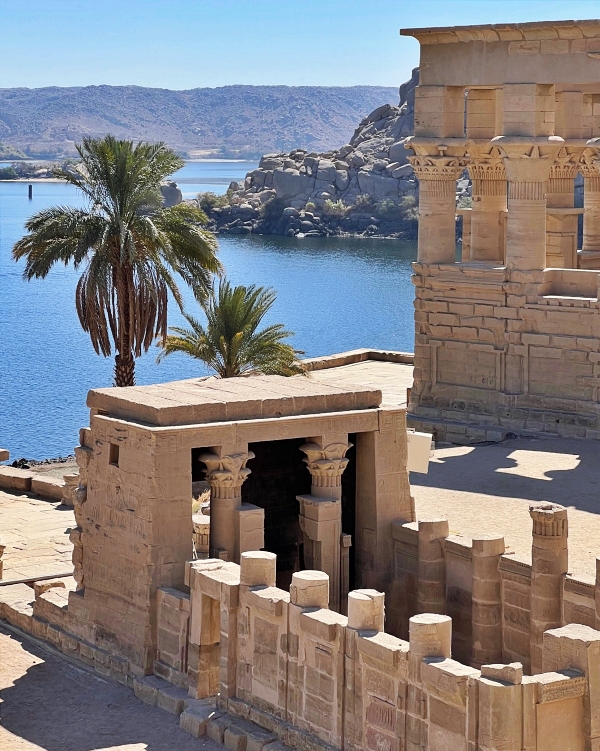
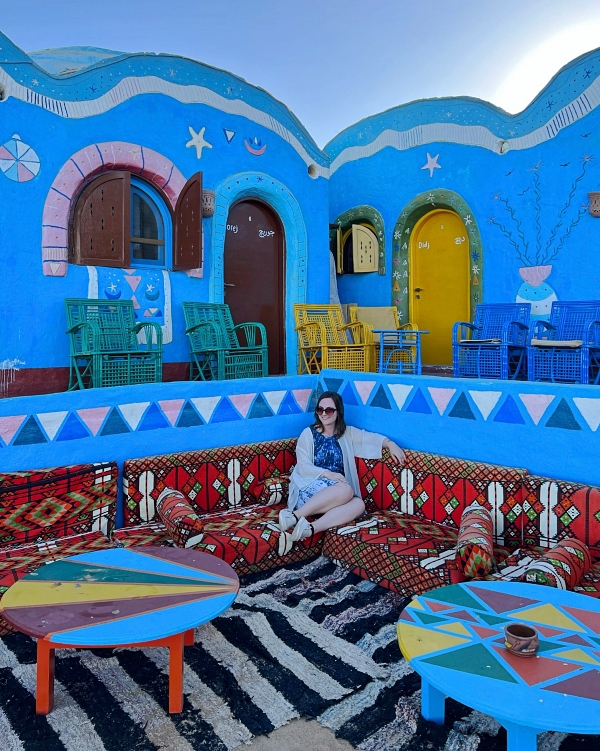
Day 5 · Abu Simbel
Aswan is a good home base for a day trip to one of Egypt’s most spectacular sights: The massive rock-cut twin temples of Abu Simbel, near the border to Sudan. It was built by Ramesses II over 3000 years ago to demonstrate the grandeur of the New Kingdom, and intended as a lasting monument to himself and his favorite queen Nefertari—but over time, it was covered by sand and forgotten. It was rediscovered in the early 19th century, and in the 1960’s, it was famously dismantled and relocated to higher ground in a multinational effort to keep it from being submerged after the building of the Aswan High Dam. I’d go as far as calling it Ancient Egypt’s masterpiece, and it is completely worth spending some seven hours driving through the desert. Interestingly, most day trip tours leave around 4AM to get there when temperatures are manageable, so if you’re willing to take the blistering heat to avoid the worst crowds, consider leaving at a normal hour and get there at noon, when most groups leave—which is what we did! We still made it back to Aswan with enough time for a one hour felucca ride on the Nile to close out the day—drifting around the islands in a traditional wooden boat with a single canvas sail was a nice way to get a small taste of a Nile-cruising experience!
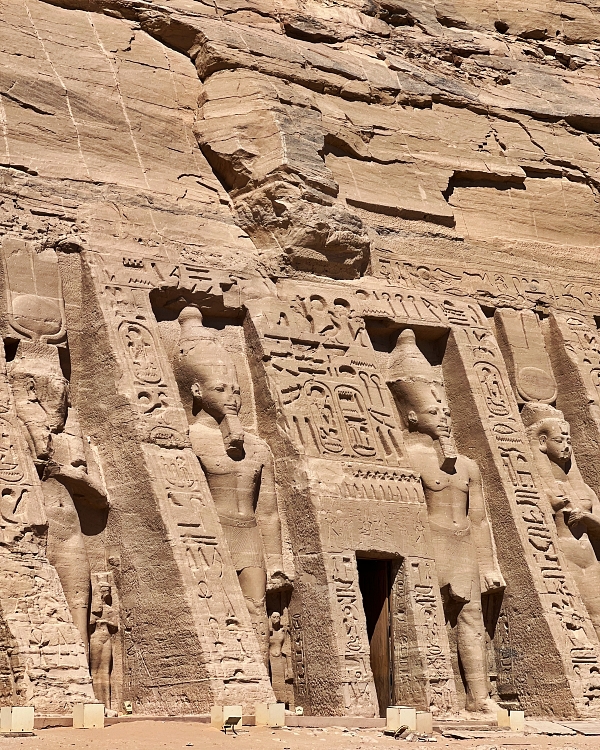

Day 6 · Aswan to Luxor drive: Kom Ombo, Edfu, and Esna
This would be one the two easiest days to cut in order to get this itinerary down to one week if you’re short on time—driving the direct route from Aswan to Luxor takes about three and a half hours, so you could easily get there by noon and visit the East Bank sights… but there are three stunning temples between the two cities, and I really recommend the scenic detour, this was my favorite day. After driving a little over an hour, you’ll reach the Temple of Kom Ombo, unusual and unique in Egypt: It’s a double temple dedicated to two different gods, the crocodile god Sobek and the falcon god Haroeris, a form of Horus, and is thus built perfectly symmetrically along the main axis. There are some remarkable reliefs, such as one depicting surgical instruments, and a numerical representation of the seasons: An Ancient Egyptian calendar! Since Sobek was revered here, over three hundred crocodile mummies were discovered in the vicinity, and a few of them are displayed in the small Crocodile Museum by the exit.
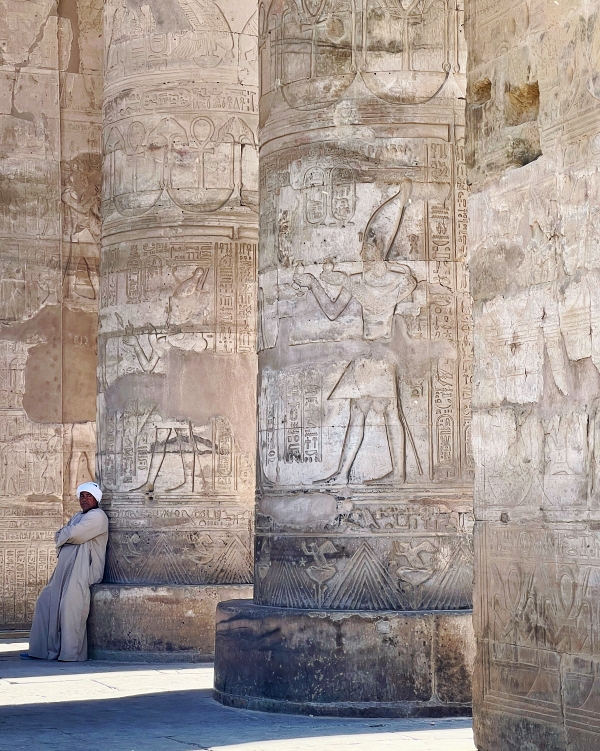
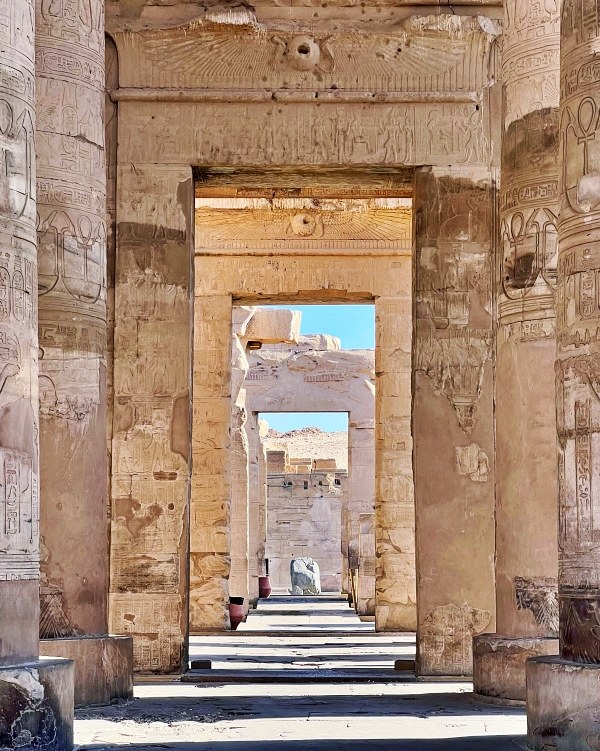
After a little under two hours on the road, you’ll cross over to the West Bank of the Nile to the Temple of Edfu, the largest dedicated to Horus. It’s one of the most atmospheric ones in the country—it was preserved by desert sand, and is thus near-intact; it’s one of just a few Egyptian temples that retains its ceiling (even though it’s blackened by soot from old fires).
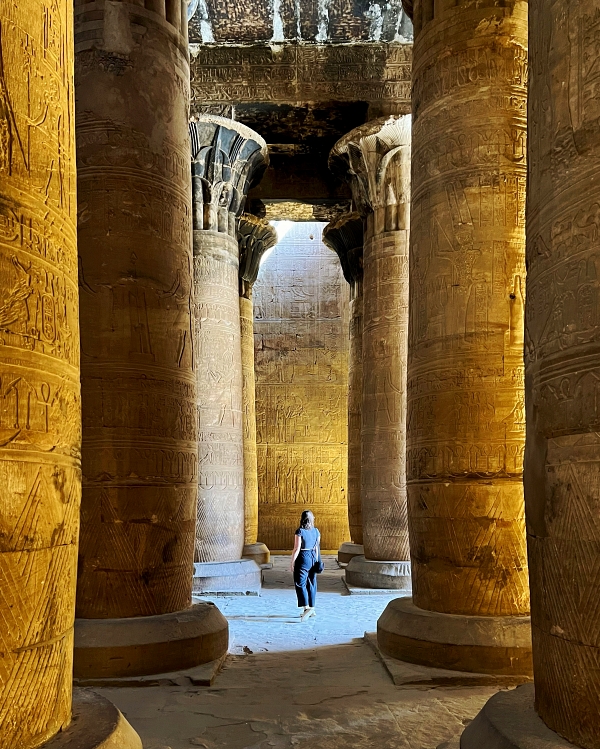

We drove some 1.5 hours on the East Bank before crossing back over to the West Bank via the Esna Barrage, a dam built to regulate the Nile. The dam causes a 10m difference in the water levels, and the Esna lock serves as an elevator that allows cruise ships to navigate it in just 20 minutes, a marvel of engineering! Once across, we walked a couple of unassuming street blocks to the Temple of Esna, dedicated to the ram-headed god of creation Khnum. The hypostyle hall, the only part of the temple that is excavated and accessible, was added by the Romans, and it had just undergone a restoration project… the colors were breathtaking, and I loved the lotus-leaf capitals, which were different on each column! From here, you’ll be in Luxor within an hour.

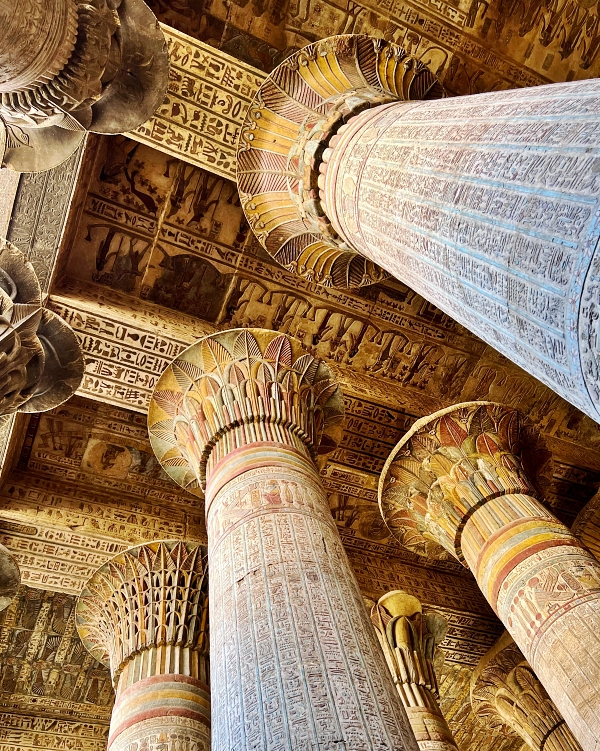
Day 7 · Luxor Part I: West Bank
The dry river valley on the West Bank of Luxor contains one of the largest collections of archaeological treasures in the world: It was the necropolis of ancient Thebes (modern Luxor), and is filled with tombs and mortuary temples. The first monuments you will see are the two faceless Colossi of Memnon, each cut from a single block of stone, rising 18m from the plain—it’s a quick stop, and I recommend leaving it for the end of the day, and heading straight to the Valley of the Kings instead, the burial ground for pharaohs of the prosperous New Kingdom. There are over sixty tombs in the area, but only a handful are open to the public, and only three of those are included in the entrance ticket. I recommend doing your research ahead of time so you know which ones to pick—our choices were Ramesses III, Ramesses IV, and Ramesses IX. There are also additional tombs that can be visited with an extra ticket, and out of those, we visited the joint tomb of Ramesses V & VI (it’s spectacular—both photos below were taken in this one), as well as the Tomb of Ay. The latter is not located in the Valley of Kings proper, but in the Valley of Monkeys—it’s a rugged drive or long, exposed, and dusty walk to get here, and since it’s the only open tomb in this valley, it gets virtually no visitors… so the guardian let me (un)lock it! The leading theory is that this tomb was meant for Tutankhamun, but they had to make do with the small one he ended up in when he died prematurely, so this tomb went to his successor Ay. It’s nowhere near as big or lavishly decorated as the others we visited, but the atmospheric setting in this remote, quiet valley made it of my favorite experiences.
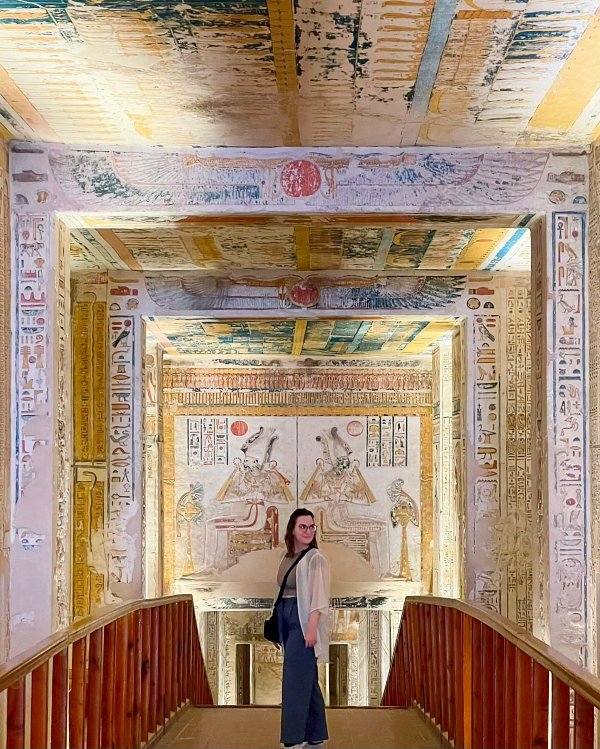

After this, we headed to the Howard Carter House, the domed mud-brick house where the British archeologist lived during his search for Tutankhamun’s tomb. It’s been restored and turned into an interesting small museum, and at the edge of the garden, an exact replica of Tutankhamun’s burial chamber was constructed in order to take some pressure off the original tomb, which is deteriorating because of the large amount of visitors. Our guide said that the first time he stepped into it he couldn’t believe how real it looks—cracks in the sarcophagus and pitting on the walls included. The store room, which isn’t accessible in the original tomb, has mounted displays about the discovery of the tomb as well as the process of replicating it. After this, we headed to the mortuary Temple of Hatshepsut, one of just a few female pharaohs, and the first to attain the full power of the position. Built into the cliff, it has a colonnaded structure and consists of three terraces connected with long ramps, making it a memorable, unique sight, different from any other temple in Egypt. It’s the West Bank’s most popular monument after the VOK tombs, so if you have more than one day, I recommend visiting it first thing on another day to avoid both the crowds and the punishing midday heat.
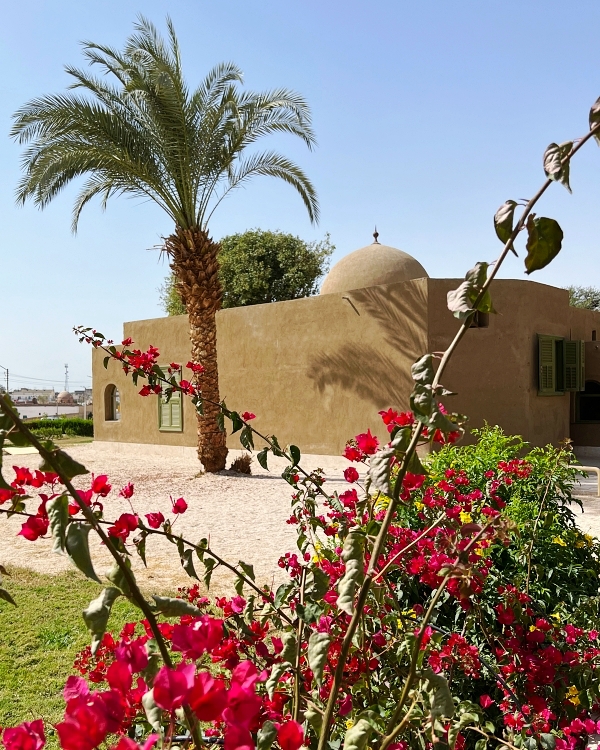
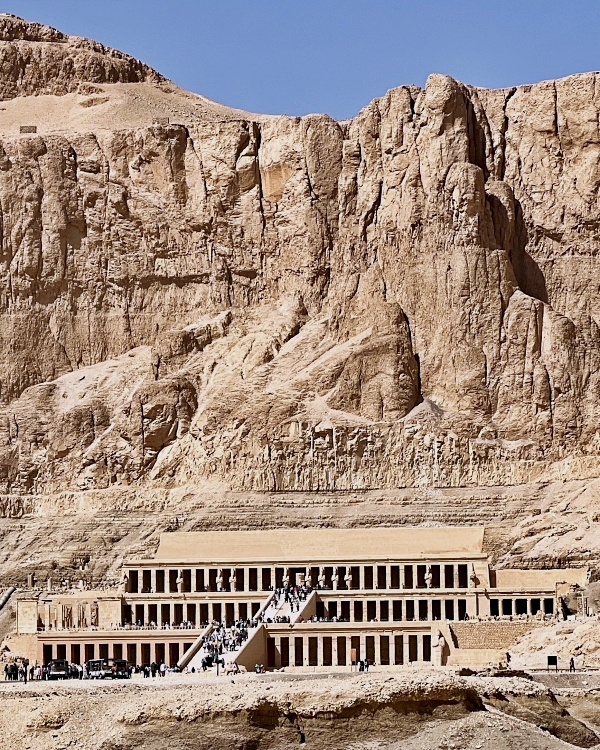
The Ramesseum is the memorial temple of the great warrior pharaoh Ramesses II, and since it usually doesn’t make the must-visit-lists, it’s a nice reprieve after the busy temple of Hatshepsut. Nestled in the foothills opposite the temple is the probably best least-visited attraction on the West Bank: The tombs in the Valley of the Nobles. Tickets are sold in sets, so we visited five tombs: Those of Sennefer and Rekhmire, and those of Ramose, Userhat and Khaemhat. If you want to choose just one, I recommend the first pair for the tomb of Sennefer alone: The descent felt pretty adventurous, and they couldn’t even out the ceiling during construction, so they left it bumpy and decorated it with grape vines—it’s unique and stunning.

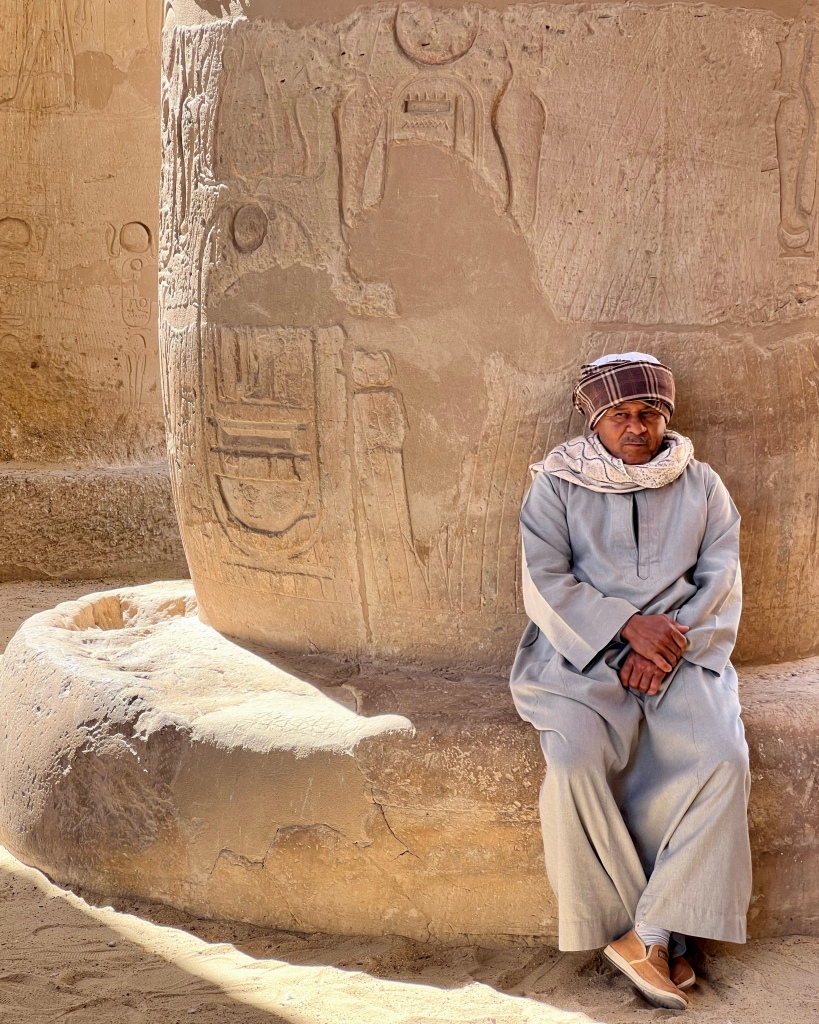
More tombs await in another one of the West Bank’s best kept secrets: Deir el-Medina, the Valley of the Artisans. You can admire the remains of the village where the workers who built and decorated the royal tombs in the Valley of the Kings lived, and in the cliffs above, you can visit some of their own tombs—they are obviously much smaller than those of the royals and nobles, but I was blown away by how finely decorated and colorful they were. End your day at Medinet Habu to visit the well-preserved mortuary temple of Ramesses III, and don’t forget to stop at the Colossi of Memnon for a quick photo op as you leave!

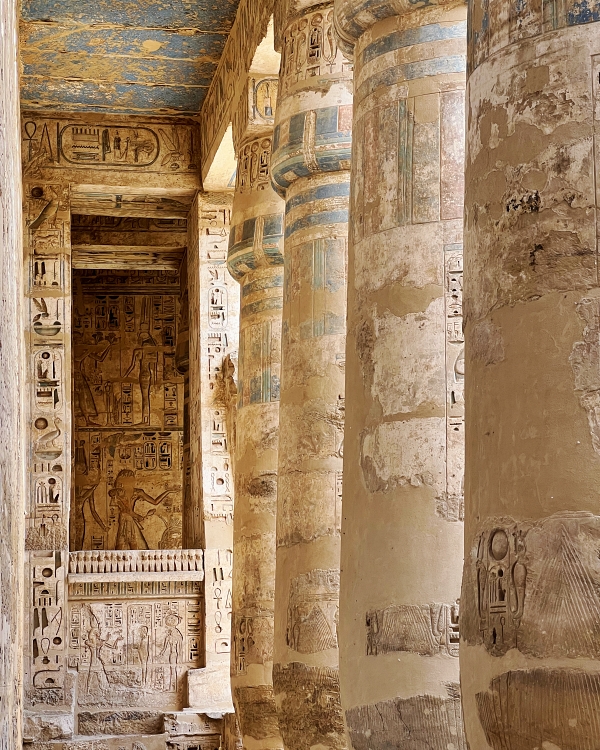
Everything I’ve mentioned here, we actually did in two days—but on the first one, we were done by 2PM, and on the second, by noon, and since I’m just not the type for sitting around a pool, in retrospect I wish we’d condensed the West Bank sights into one (admittedly very full) day—it could be done, especially because we are used to skipping lunch. However, if you’re someone who likes to take it easy on vacation (…what’s that like?), you may want to keep it as two separate days, which will also allow you to add more activities, such as a sunrise hot air balloon ride or a sunset boat ride on the Nile, and more sights, such as the Valley of the Queens.
Day 8 · Luxor Part II: East Bank
There is nowhere near as much to see on the East Bank of Luxor as on the West Bank—half a day is plenty, and that’s including the Luxor and Mummification museums, which we skipped. If the previous day as detailed above is too busy for your liking, but you don’t want to cut anything from the list, you may consider splitting your second day among the two banks to see some more on the West side. Anyhow, by this point, our guide had noticed that I’m into taking pictures, so he suggested we get a late start for a change, in order to enjoy Karnak Temple during golden hour, and Luxor temple in time for sunset and to see it lit up. He meant well, and while they were both spectacular at this time of day, they were also extremely busy, and if I were to do it again, I’d insist on visiting them first ting in the morning, as I had originally intended. Built and expanded over a period of some 2000 years, the Karnak Temple complex is the second largest temple complex in the world, and the second most visited site in Egypt after the pyramids of Giza. About thirty pharaohs contributed to the buildings, trying to out-do their predecessors, thus enabling Karnak to reach a size, complexity, and diversity not seen elsewhere. The Precinct of Amun-Ra, one of four main sections, is the one open to the public, and its crown jewel the Great Hypostyle hall: 134 columns in 16 rows on an area of 5000 square meters, intricately decorated in both sunk and raised relief. After Karnak, we visited Luxor Temple, which, not being dedicated to a particular god or pharaoh, is believed to have functioned as the ending point of the ritual journey during the annual Opet festival, which started in Karnak, and proceeded along the Avenue of Sphinxes connecting the two temples. One of the obelisks flanking the entrance is missing, having been moved to Place de la Concorde in Paris in 1836.


Day 9 · Luxor, Part III: Day trip to the temples of Abydos and Dendera
This day trip involves about six hours spent in a car, so if that doesn’t sound appealing, you want to keep the number of days down, or “temple fatigue” has set in, it’s one you may consider cutting from your itinerary. However, the two temples are some of the best-preserved and least busy in the country, and we thought them well worth the time. Most day trips start with the Temple of Abydos, the one that’s further away, stopping at the Temple of Dendera on the way back. Abydos, one of the oldest cities of Ancient Egypt, is considered to be one of the most important archaeological sites in the country: It is was a royal necropolis where the early pharaohs were buried, and a pilgrimage site for ancient Egyptians. You’ll visit the atmospheric Temple of Seti I, which was completed by his son Ramesses II—it felt strangely remote despite being in the middle of a town, like stepping back in time… and it was the only tourist site in the country that only accepted cash payments, so keep some Egyptian pounds aside for it. On the return drive towards Luxor, you’ll stop at the Temple of Dendara, dedicated to Hathor. It remains largely intact, with dark chambers, underground crypts and twisting stairways, all carved with hieroglyphs, but its most awe-inspiring feature is the hypostyle hall: Twenty-four columns featuring the head of Hathor support a ceiling decorated in a brilliant blue hue. With extra tickets, you can access the roof for the view, and climb down to the catacombs.
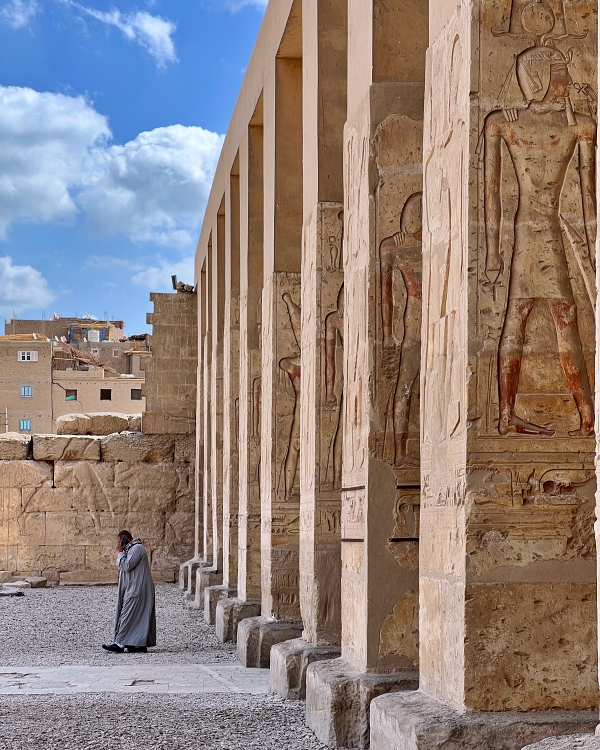
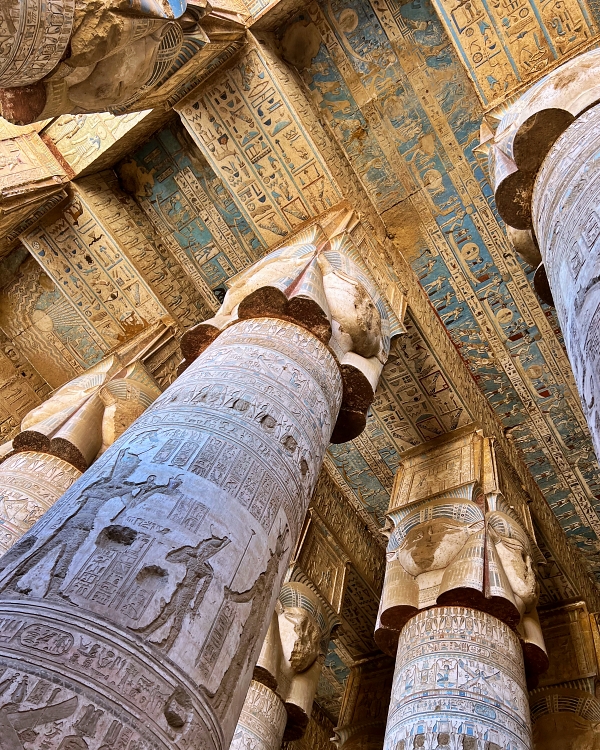
Day 10 · Departure
We took the overnight train back to Cairo from Luxor train station at the end of our day trip to Abydos and Dendera, and continued on to Alexandria, which we thought was a colossal waste of time and money, and wouldn’t recommend. So, depending on how you decide to string together your days in Luxor, you could spare yourself this “wasted” travel day by doing the East Bank sights in the morning, and then flying to Cairo and connecting to your final destination that same afternoon and evening, which is what I wish we would’ve done!
